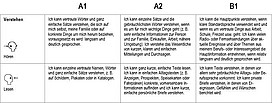Course Levels
The course levels are based on the language level guidelines of the Common European Framework of Reference for Languages (CEFR) of the Council of Europe. You can use the checklists (self-assessment forms A1–C2) provided here to assess your own language level.
Self-assessment procedure
- Read the short description of the level
- Select the level you think you are at (A1–C2)
- Open the self-assessment form of the course level (for example, A2) on the homepage and print it off
- Fill in the self-assessment form carefully
- Calculate your result (percentage of the skills you possess)
- Use this result to choose the right course for you from our course offerings. If you possess 80% of the skills listed, you should choose a course at the next level.
The levels are as follows:
| Level according to the CEFR (A1-C2) | Course title | Short description of the level |
|---|---|---|
| A1―Breakthrough | Breakthrough 1/1st phase |
|
| Breakthrough 2/2nd phase |
| |
| A2―Waystage | Waystage 3/1st phase |
|
| Waystage 4/2nd phase |
| |
| B1―Threshold | Threshold 1/1st phase |
|
| Threshold 2/2nd phase |
| |
| B2―Vantage | Vantage 3/1st phase |
|
| Vantage 4/2nd phase |
| |
| C1―Effectiveness | Effectiveness 1/1st phase |
|
| Effectiveness 2/2nd phase |
| |
| C2―Mastery | No courses offered at this level |
|
In the following, you will find a short description of the skills you should possess at each level. Evaluate your language skills. If you already possess the skills of one level, you should choose a course at the next level.
- A1 Breakthrough ― self-assessment form A1
Can understand and use familiar everyday expressions and very basic phrases aimed at the satisfaction of needs of a concrete type. Can introduce him/herself and others and can ask and answer questions about personal details such as where he/she lives, people he/she knows and things he/she has. Can interact in a simple way provided the other person talks slowly and clearly and is prepared to help.
- A2 Waystage ― self-assessment form A2
Can understand sentences and frequently used expressions related to areas of most immediate relevance (e.g. very basic personal and family information, shopping, local geography, employment). Can communicate in simple and routine tasks requiring a simple and direct exchange of information on familiar and routine matters. Can describe in simple terms aspects of his/her background, immediate environment and matters in areas of immediate need
- B1 Threshold ― self-assessment form B1
Can understand the main points of clear standard input on familiar matters regularly encountered in work, school, leisure, etc. Can deal with most situations likely to arise whilst travelling in an area where the language is spoken Can produce simple connected text on topics that are familiar or of personal interest. Can describe experiences and events, dreams, hopes and ambitions and briefly give reasons and explanations for opinions and plans.
- B2 Vantage ― self-assessment form B2
Can understand the main ideas of complex text on both concrete and abstract topics, including technical discussions in his/her field of specialisation. Can interact with a degree of fluency and spontaneity that makes regular interaction with native speakers quite possible without strain for either party. Can produce clear, detailed text on a wide range of subjects and explain a viewpoint on a topical issue giving the advantages and disadvantages of various options.
- C1 Effectiveness ― self-assessment form C1
Can understand a wide range of demanding, longer texts, and recognise implicit meaning. Can express him/herself fluently and spontaneously without much obvious searching for expressions. Can use language flexibly and effectively for social, academic and professional purposes. Can produce clear, well-structured, detailed text on complex subjects, showing controlled use of organisational patterns, connectors and cohesive devices.
- C2 Mastery ― self-assessment form C2
Can understand with ease virtually everything heard or read. Can summarise information from different spoken and written sources, reconstructing arguments and accounts in a coherent presentation. Can express him/herself spontaneously, very fluently and precisely, differentiating finer shades of meaning even in the most complex situations.

